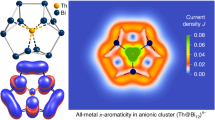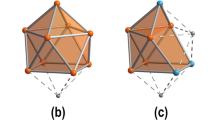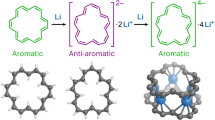Abstract
Anti-aromatic compounds, as well as small cyclic alkynes or carbynes, are particularly challenging synthetic goals. The combination of their destabilizing features hinders attempts to prepare molecules such as pentalyne, an 8π-electron anti-aromatic bicycle with extremely high ring strain. Here we describe the facile synthesis of osmapentalyne derivatives that are thermally viable, despite containing the smallest angles observed so far at a carbyne carbon. The compounds are characterized using X-ray crystallography, and their computed energies and magnetic properties reveal aromatic character. Hence, the incorporation of the osmium centre not only reduces the ring strain of the parent pentalyne, but also converts its Hückel anti-aromaticity into Craig-type Möbius aromaticity in the metallapentalynes. The concept of aromaticity is thus extended to five-membered rings containing a metal–carbon triple bond. Moreover, these metal–aromatic compounds exhibit unusual optical effects such as near-infrared photoluminescence with particularly large Stokes shifts, long lifetimes and aggregation enhancement.
This is a preview of subscription content, access via your institution
Access options
Subscribe to this journal
Receive 12 print issues and online access
$259.00 per year
only $21.58 per issue
Buy this article
- Purchase on Springer Link
- Instant access to full article PDF
Prices may be subject to local taxes which are calculated during checkout





Similar content being viewed by others
References
Minkin, V. I., Glukhovtsev, M. N. & Simkin, B. Y. Aromaticity and Antiaromaticity: Electronic and Structural Aspects (Wiley, 1994).
De Proft, F. & Geerlings, P. Conceptual and computational DFT in the study of aromaticity. Chem. Rev. 101, 1451–1464 (2001).
Cyranski, M. K. Energetic aspects of cyclic pi-electron delocalization: evaluation of the methods of estimating aromatic stabilization energies. Chem. Rev. 105, 3773–3811 (2005).
Thorn, D. L. & Hoffmann, R. Delocalization in metallocycles. Nouv. J. Chim. 3, 39–45 (1979).
Elliott, G. P., Roper, W. R. & Waters, J. M. Metallacyclohexatrienes or ‘metallabenzenes.’ Synthesis of osmabenzene derivatives and X-ray crystal structure of [Os(CSCHCHCHCH)(CO)(PPh3)2]. J. Chem. Soc. Chem. Commun. 811–813 (1982).
Hückel, E. Quantum-theoretical contributions to the benzene problem. I. The electron configuration of benzene and related compounds. Z. Phys. 70, 204–286 (1931).
Craig, D. P. & Paddock, N. L. A novel type of aromaticity. Nature 181, 1052–1053 (1958).
Heilbronner, E. Hückel molecular orbitals of Möbius-type conformations of annulenes. Tetrahedron Lett. 29, 1923–1928 (1964).
Rzepa, H. S. Möbius aromaticity and delocalization. Chem. Rev. 105, 3697–3715 (2005).
Mauksch, M., Gogonea, V., Jiao, H. & Schleyer, P. v. R. Monocyclic (CH)9 +— a Heilbronner Möbius aromatic system revealed. Angew. Chem. Int. Ed. 37, 2395–2397 (1998).
Wiberg, K. B. Antiaromaticity in monocyclic conjugated carbon rings. Chem. Rev. 101, 1317–1331 (2001).
Gleiter, R. & Merger, R. in Modern Acetylene Chemistry (eds Stang, P. J. & Diederich, F.) Ch. 8 (VCH, 1995).
Wittig, G. Small rings with carbon–carbon triple bonds. Angew. Chem. Int. Ed. Engl. 1, 415–419 (1962).
Montgomery, L. K., Scardiglia, F. & Roberts, J. D. Evidence for cyclohexyne and cyclopentyne as intermediates in the coupling reactions of phenyllithium with 1-chlorocyclohexene and 1-chlorocyclopentene. J. Am. Chem. Soc. 87, 1917–1925 (1965).
Krebs, A. & Kimling, H. 3,3,7,7-Tetramethylcycloheptyne, an isolable seven-membered carbocyclic alkyne. Angew. Chem. Int. Ed. Engl. 10, 509–510 (1971).
Chapman, O. L. et al. Photochemical transformations. LII. Benzyne. J. Am. Chem. Soc. 95, 6134–6135 (1973).
Chapman, O. L., Gano, J., West, P. R., Regitz, M. & Maas, G. Acenaphthyne. J. Am. Chem. Soc. 103, 7033–7036 (1981).
Krebs, A. & Wilke, J. Angle strained cycloalkynes. Top. Curr. Chem. 109, 189–233 (1983).
Suzuki, N., Nishiura, M. & Wakatsuki, Y. Isolation and structural characterization of 1-zirconacyclopent-3-yne, five-membered cyclic alkynes. Science 295, 660–663 (2002).
Suzuki, N., Hashizume, D., Koshino, H. & Chihara, T. Transformation of a 1-zirconacyclopent-3-yne, a five-membered cycloalkyne, into a 1-zirconacyclopent-3-ene and formal ‘1-zirconacyclopenta-2,3-dienes’. Angew. Chem. Int. Ed. 47, 5198–5202 (2008).
Suzuki, N. & Hashizume, D. Five-membered metallacycloalkynes formed from group 4 metals and [n]cumulene (n = 3,5) ligands. Coord. Chem. Rev. 254, 1307–1326 (2010).
Suzuki, N. et al. Characterization of the E isomer of tetrasubstituted [5]cumulene and trapping of the Z isomer as a zirconocene complex. Organometallics 30, 3544–3548 (2011).
Wen, T. B., Zhou, Z. Y. & Jia, G. Synthesis and characterization of a metallabenzyne. Angew. Chem. Int. Ed. 40, 1951–1954 (2001).
Jia, G. Progress in the chemistry of metallabenzynes. Acc. Chem. Res. 37, 479–486 (2004).
Jia, G. Recent progress in the chemistry of osmium carbyne and metallabenzyne complexes. Coord. Chem. Rev. 251, 2167–2187 (2007).
He, G. et al. A metallanaphthalyne complex from zinc reduction of a vinylcarbyne complex. Angew. Chem. Int. Ed. 46, 9065–9068 (2007).
Liu, B. et al. Selective synthesis of osmanaphthalene and osmanaphthalyne by intramolecular C–H activation. Angew. Chem. Int. Ed. 48, 5461–5464 (2009).
Jones, W. M. & Klosin, J. Transition-metal complexes of arynes, strained cyclic alkynes, and strained cyclic cumulenes. Adv. Organomet. Chem. 42, 147–221 (1998).
Rosenthal, U. Stable cyclopentynes—made by metals!? Angew. Chem. Int. Ed. 43, 3882–3887 (2004).
Lamač, M. et al. Formation of a 1-zircona-2,5-disilacyclopent-3-yne: coordination of 1,4-disilabutatriene to zirconocene? Angew. Chem. Int. Ed. 49, 2937–2940 (2010).
Jemmis, E. D., Phukan, A. K., Jiao, H. & Rosenthal, U. Structure and neutral homoaromaticity of metallacyclopentene, -pentadiene, -pentyne, and -pentatriene: a density functional study. Organometallics 22, 4958–4965 (2003).
Xia, H. et al. Osmabenzenes from the reactions of HC≡CCH(OH)C≡CH with OsX2(PPh3)3 (X = Cl, Br). J. Am. Chem. Soc. 126, 6862–6863 (2004).
Ugolotti, J. et al. Five-membered metallacyclic allenoids: synthesis and structure of remarkably stable strongly distorted cyclic allene derivatives. Angew. Chem. Int. Ed. 47, 2622–2625 (2008).
Rosenthal, U. et al. Synthesis and structure of the smallest cyclic cumulene; reaction of 1,3-diynes with zirconocene complexes. Angew. Chem. Int. Ed. Engl. 33, 1605–1607 (1994).
Rosenthal, U., Burlakov, V. V., Arndt, P., Baumann, W. & Spannenberg, A. Five-membered titana- and zirconacyclocumulenes: stable 1-metallacyclopenta-2,3,4-trienes. Organometallics 24, 456–471 (2005).
Luecke, H. F. & Bergman, R. G. Synthesis, structural characterization, and chemistry of a monomeric cationic iridium carbyne complex. J. Am. Chem. Soc. 120, 11008–11009 (1998).
Frisch, M. J. et al. Gaussian 03, Revision E.01 (Gaussian, 2004).
Ng, S. M., Huang, X., Wen, T. B., Jia, G. & Lin, Z. Theoretical studies on the stabilities of metallabenzynes. Organometallics 22, 3898–3904 (2003).
Schleyer, P. v. R., Maerker, C., Dransfeld, A., Jiao, H. & Hommes, N. J. R. v. E. Nucleus-independent chemical shifts: a simple and efficient aromaticity probe. J. Am. Chem. Soc. 118, 6317–6318 (1996).
Jiao, H., Schleyer, P. v. R., Mo, Y., McAllister, M. A. & Tidwell, T. T. Magnetic evidence for the aromaticity and antiaromaticity of charged fluorenyl, indenyl, and cyclopentadienyl systems. J. Am. Chem. Soc. 119, 7075–7083 (1997).
Chen, Z., Wannere, C. S., Corminboeuf, C., Puchta, R. & Schleyer, P. v. R. Nucleus-independent chemical shifts (NICS) as an aromaticity criterion. Chem. Rev. 105, 3842–3888 (2005).
Fallah-Bagher-Shaidaei, H., Wannere, C. S., Corminboeuf, C., Puchta, R. & Schleyer, P. v. R. Which NICS aromaticity index for planar π rings is best? Org. Lett. 8, 863–866 (2006).
Glendening, E. D. et al. NBO 5.0 (Theoretical Chemistry Institute, University of Wisconsin, 2001).
Schleyer, P. v. R. & Pühlhofer, F. Recommendations for the evaluation of aromatic stabilization energies. Org. Lett. 4, 2873–2876 (2002).
Wannere, C. S. et al. On the stability of large [4n]annulenes. Org. Lett. 5, 2983–2986 (2003).
Lakowicz, J. R. Principles of Fluorescence Spectroscopy 3rd edn (Springer, 2006).
Moore, E. G., Samuel, A. P. S. & Raymond, K. N. From antenna to assay: lessons learned in lanthanide luminescence. Acc. Chem. Res. 42, 542–552 (2009).
Escobedo, J. O., Rusin, O., Lim, S. & Strongin, R. M. NIR dyes for bioimaging applications. Curr. Opin. Chem. Biol. 14, 64–70 (2010).
Hong, Y., Lam, J. W. Y. & Tang, B. Z. Aggregation-induced emission. Chem. Soc. Rev. 40, 5361–5388 (2011).
Mauksch, M. & Tsogoeva, S. B. Demonstration of “Möbius” Aromaticity in Planar Metallacycles. Chem. Eur. J. 16, 7843–7851 (2010).
Acknowledgements
This research was supported by the National Science Foundation of China (grant nos. 20925208, 21172184, 21175113 and 21273177), the National Basic Research Program of China (nos. 2012CB821600 and 2011CB808504), the Program for Changjiang Scholars and Innovative Research Team in University of China, and US-NSF Grant CHE 105-7466. The authors thank E. Meggers at Philipps-Universität Marburg, Zhenyang Lin at the Hong Kong University of Science and Technology, Yirong Mo at Western Michigan University, and Xinzheng Yang at the University of California, Berkeley, for their suggestions, and, in particular J. I-Chia Wu, Georgia, for instructive discussions and her assistance with aromaticity analyses.
Author information
Authors and Affiliations
Contributions
H.X. conceived the project. C.Z., M.L. and X.Z. performed the experiments. S.L. and Y.N. conducted the luminescence study of osmapentalynes. C.Z. and T.W. recorded all NMR data and solved all X-ray structures. H.X., C.Z. and T.W. analysed the experimental data. J.Z. conceived the theoretical work and, with M.-L.L., conducted theoretical computations. J.Z., X.L., Z.C., M.-L.L. and P.v.R.S. analysed and interpreted the computational data. J.Z., H.X., S.L. and C.Z. drafted the paper, with support from Z.C., X.L., T.W. and Z.X., as well as language editing by P.v.R.S. All authors discussed the results and contributed to the preparation of the final manuscript.
Corresponding authors
Ethics declarations
Competing interests
The authors declare no competing financial interests.
Supplementary information
Supplementary information
Supplementary information (PDF 2404 kb)
Supplementary information
Crystallographic data for compound 2a. (CIF 26 kb)
Supplementary information
Crystallographic data for compound3a. (CIF 27 kb)
Supplementary information
Crystallographic data for compound 4. (CIF 27 kb)
Supplementary information
Crystallographic data for compound 5. (CIF 27 kb)
Rights and permissions
About this article
Cite this article
Zhu, C., Li, S., Luo, M. et al. Stabilization of anti-aromatic and strained five-membered rings with a transition metal. Nature Chem 5, 698–703 (2013). https://doi.org/10.1038/nchem.1690
Received:
Accepted:
Published:
Issue Date:
DOI: https://doi.org/10.1038/nchem.1690
This article is cited by
-
Synthesis of metalla-dual-azulenes with fluoride ion recognition properties
Nature Communications (2023)
-
Ring contraction of metallacyclobutadiene to metallacyclopropene driven by π- and σ-aromaticity relay
Nature Synthesis (2022)
-
A tris-spiro metalla-aromatic system featuring Craig-Möbius aromaticity
Nature Communications (2021)
-
Addition of alkynes and osmium carbynes towards functionalized dπ–pπ conjugated systems
Nature Communications (2020)
-
Open questions on aromaticity in organometallics
Communications Chemistry (2020)



